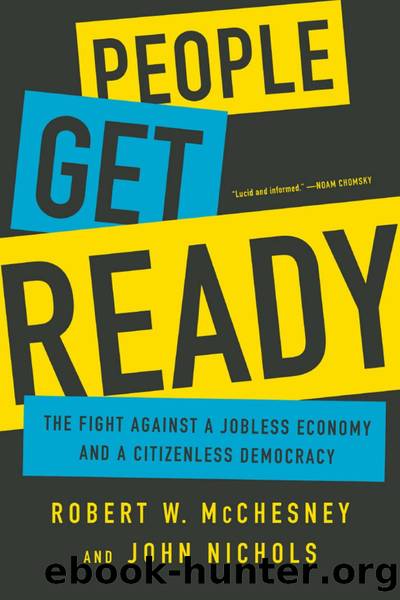People Get Ready: The Fight Against a Jobless Economy and a Citizenless Democracy by Robert W. McChesney & John Nichols

Author:Robert W. McChesney & John Nichols
Language: eng
Format: mobi, azw3
Tags: Non-Fiction, Science, Economics, Journalism, Writing, United States, Society, Politics, Technology
ISBN: 9781568585222
Publisher: Hachette UK
Published: 2016-03-08T00:00:00+00:00
By every conceivable indicator, our army that now remains in Vietnam is in a state approaching collapse, with individual units avoiding or having refused combat, murdering their officers and non commissioned officers, drug-ridden, and dispirited where not near mutinous.
Elsewhere than Vietnam, the situation is nearly as serious.147
Indeed, Army bases were often adjacent to left-wing coffee shopsâsometimes affiliated with the FTA148 movementâand African American, Latino, and a significant number of white GIs were radicalized. It convinced the brass that the draft was no longer viable and led to the institution of a professional army.149
When these veterans returned to jobs in American factories they brought an entirely new sensibility to a generation of workers already changing with the times. âWith all the shoulder-length hair, beards, Afros and mod clothing along the line,â Newsweek observed after a visit to the Lordstown, Ohio, GM plant, âit looks for all the world like an industrial Woodstock.â150 By 1970 the âsituation exploded in an upsurge of pent-up rank-and-file militancy,â as historian David Noble explained.151 The early 1970s saw the greatest wave of strike activity, work stoppages, slowdowns, and wildcat strikes since 1946. In 1970 alone 2.4 million workers engaged in large-scale work stoppages of one kind or another. The Wall Street Journal characterized the situation as âthe worst within memory.â152 There were aggressive attempts led by young workers to take over the steelworkers and mineworkers unions, among others, and throw out the traditional leadership. Management was âdealing with a workforce,â Fortune informed its readers, âno longer under union discipline.â153
The concerns of the workers were far more than wages and benefits; after all, real wages for male workers hit their historic peak in 1972. Automation, both in its elimination of jobs and dehumanization of those that remained, was a huge issue for the young workers. As Noble put it, workers were not happy with âmanagementâs obsession with and struggle for control over workers.â154 âIt is imperative for labor,â dissident young longshoremen wrote in a 1971 pamphlet opposing union leadership and management, âto challenge the notion that the employerâin the name of âprogressââcan simply go ahead and slash his workforce or close his factory or, as is being planned in our industry, close an entire port, and to do so without any regard for the people and community involved.â155
âAt the heart of the new mood,â the New York Times reported, âthere is a challenge to managementâs authority to run its plants, an issue that has resulted in some of the hardest fought battles between industry and labor in the past.â The symbol of this new wave was the three-week-long 1972 strike at the Lordstown plant led by âa group of young, hip, and inter-racial autoworkersâ whose primary issue was opposing the âfastestâand most psychically deadeningâassembly line in the world.â156 There were efforts to link this working-class radicalism to student and antiwar activists and liberals in general. As progressive journalist Jack Newfield put it in 1971, the way to unite these forces was to build around âthe root need to redistribute wealth and the commitment to broaden democratic participation.
Download
People Get Ready: The Fight Against a Jobless Economy and a Citizenless Democracy by Robert W. McChesney & John Nichols.azw3
This site does not store any files on its server. We only index and link to content provided by other sites. Please contact the content providers to delete copyright contents if any and email us, we'll remove relevant links or contents immediately.
Zero to IPO: Over $1 Trillion of Actionable Advice from the World's Most Successful Entrepreneurs by Frederic Kerrest(4403)
Machine Learning at Scale with H2O by Gregory Keys | David Whiting(4258)
Never by Ken Follett(3882)
Harry Potter and the Goblet Of Fire by J.K. Rowling(3808)
Ogilvy on Advertising by David Ogilvy(3552)
Shadow of Night by Deborah Harkness(3325)
The Man Who Died Twice by Richard Osman(3040)
Book of Life by Deborah Harkness(2893)
Will by Will Smith(2872)
The Tipping Point by Malcolm Gladwell(2870)
0041152001443424520 .pdf by Unknown(2812)
My Brilliant Friend by Elena Ferrante(2792)
How Proust Can Change Your Life by Alain De Botton(2771)
Purple Hibiscus by Chimamanda Ngozi Adichie(2736)
How to Pay Zero Taxes, 2018 by Jeff A. Schnepper(2621)
Hooked: A Dark, Contemporary Romance (Never After Series) by Emily McIntire(2527)
Rationality by Steven Pinker(2327)
Borders by unknow(2280)
Can't Hurt Me: Master Your Mind and Defy the Odds - Clean Edition by David Goggins(2276)
